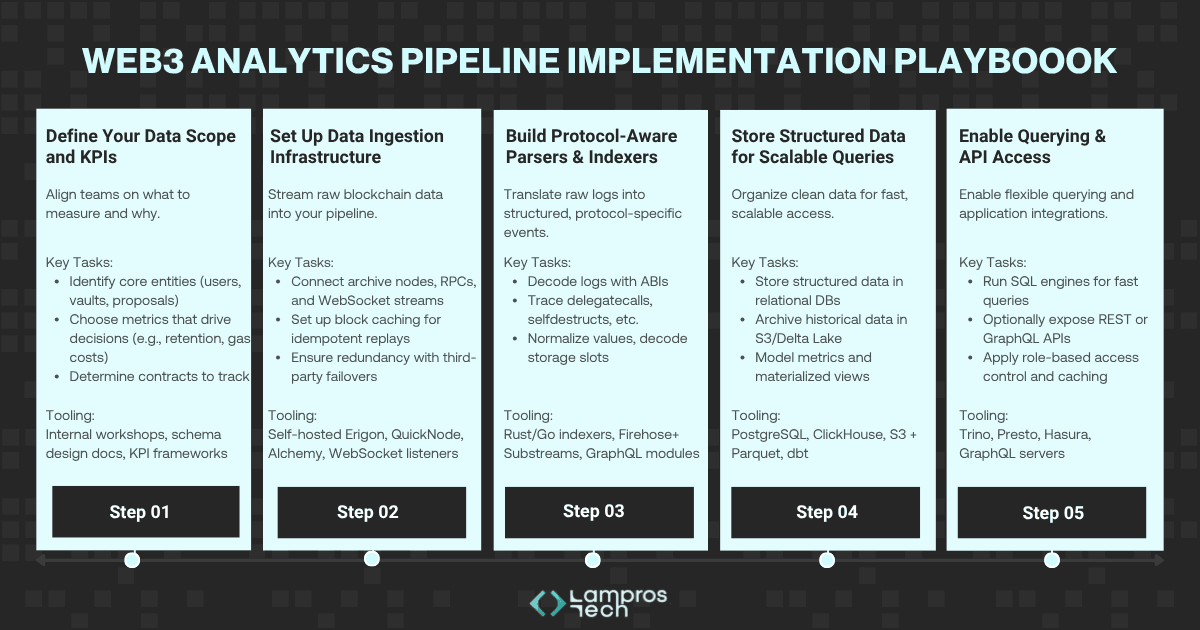Contact Us
If you're working on something real — let's talk.
Development & Integration
Blockchain Infrastructure & Tools
Ecosystem Growth & Support
© 2025 Lampros Tech. All Rights Reserved.
Published On Jul 09, 2025
Updated On Jul 14, 2025

Core Pattern | Tooling | Benefits |
|---|---|---|
Ingest raw chain data in near real-time | Kafka for high-throughput streaming | High modularity (independent consumers) |
Parse key events (Transfer, Swap, Deposit) | RabbitMQ / Redis Streams for lighter loads | Horizontal scalability |
Process asynchronously via enrichers, storage workers, and alert systems | Pub/Sub (GCP) for serverless scaling | Built-in failure handling and async retries |
Core Pattern | Tooling | Benefits |
|---|---|---|
Speed Layer: Real-time data processing via streams | Apache Spark for distributed batch jobs | Tracks token logic like rebases or rewards |
Batch Layer: Periodic reprocessing for consistency | Apache Flink for real-time streaming | Enables accurate backfills and data corrections |
Serving Layer: Merges both layers for querying | dbt for SQL-based transformations | Suits evolving schemas and complex KPIs |
Core Pattern | Tooling | Benefits |
|---|---|---|
Separate indexers for each contract group or logic type | Containerised deployments with Docker | Easier to manage contract-specific logic |
Services are emitted to a central bus or data store | Orchestration using Kubernetes | Scales dynamically based on protocol activity |
Logic is handled at the edge close to the sources | Message bus with Kafka or NATS | Reduces the blast radius from failures |
Core Pattern | Tooling | Benefits |
|---|---|---|
Each team owns and manages its own data domain | dbt with modular project structure | Enables team autonomy without central bottlenecks |
Shared standards for schema and metrics | DataHub for OpenMetadata | Improves data ownership and accountability |
Central governance ensures visibility | GitOps-driven pipelines | Scales across large DAOs or modular protocols |
Core Pattern | Tooling | Benefits |
|---|---|---|
Mix on-chain logs, off-chain APIs, and zk-compressed snapshots | Archive RPCs for on-chain data | Handles high-throughput use cases (e.g., DePIN, gaming) |
Decode calldata, traces, and state diffs | GraphQL APIs for external sources | Reduces storage with verifiable compression |
Integrate external metadata like relayers or frontends | zkIndexing middleware (e.g., Lagrange, Succinct) | Ensures trustless data pipelines |


FAQs

It’s a modular system that collects and processes on-chain data from blockchain networks. The goal is to turn raw logs into structured insights for querying, monitoring, and decision-making.

Off-the-shelf tools often miss reverted calls, custom events, and cross-chain flows. A custom pipeline gives full control over data quality, logic, and scalability.

Key layers include ingestion, indexing, transformation (ETL), storage, query access, and automation. Each plays a role in turning blockchain noise into signal.

Use internal mapping layers, normalize timestamps, and stitch user sessions across chains to track behaviour and events in a unified timeline.

Teams face schema drift, RPC gaps, usage spikes, and noisy alerts. Solving them requires good architecture, custom logic, and strong operational practices.